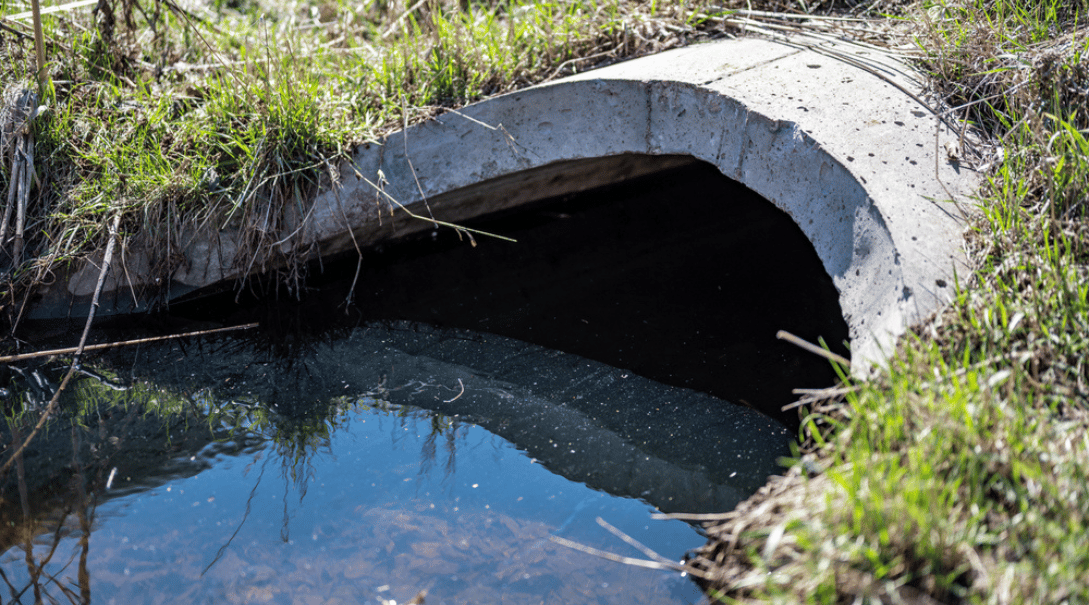If construction sites, parking lots, roads, and buildings existed in a vacuum, there would be no need for a Stormwater Pollution Protection Plan (SWPPP) to control stormwater. Unfortunately, when rain and snowfall occur on unnatural surfaces, the precipitation can’t be absorbed into the ground as it would on dirt, sand, or clay.
As a result, rain and snowmelt carry toxins from manmade areas and surfaces into the soil and nearby bodies of water. These pollutants compromise the health of local plants, wildlife, and people.
Table of Contents
What Is SWPPP?
A stormwater pollution protection plan (SWPPP) is designed to mitigate the danger of stormwater runoff. It does so by identifying methods of containing and filtering water before it can carry trash or pollutants into sensitive areas.
In 1972, the Clean Water Act established regulations requiring construction zones, sewer systems, and specific industrial facilities to develop a SWPPP and obtain a national pollutant discharge elimination system (NPDES) permit to operate.
The tactics by which an organization implements its SWPPP to contain and filter stormwater are referred to as Best Management Practices (BMPs). BMPs include measures such as:
Vegetation
Without proper vegetation and strong root systems, soil can easily wash away during rain and snowstorms. By strategically planting certain plants, they can prevent more runoff.
Covering Outdoor Toxin/Pollutant Sources
Heavy machinery such as tractors and excavators can leak oil, fuel, and other harmful substances. Covering them when not in use assures that rainwater will not wash these substances off the machinery and onto the ground.
Stormwater Containment
It is possible to contain stormwater within a particular area to avoid releasing it into the surrounding environment. Common methods of stormwater containment include barriers and sandbags.
Silt Fences
By stretching pieces of filter fabric between wood or metal posts, construction crews, and other organizations executing an SWPPP can catch sediment and soil before they escape. While silt fences cannot channel or concentrate the water, they can provide a filtering effect.
Inlet Protection
Covers over storm drain inlets can prevent runoff from entering the sewer system.
Spill Kits
Spill kits hold materials a crew can use to clean up runoff or spills. These include waste bags, PPE, and absorbent materials.
Remember that BMPs are not always SWPPPs. Instead, BMPs are the tools by which an organization will enact its SWPPP. The SWPPP is the written plan that outlines how a business or entity will contain and filter stormwater runoff.
Protecting water quality is essential for minimizing the impact on the local environment. Stormwater runoff can bring toxic substances and hazardous materials into contact with sensitive plants and animals.
Fish can absorb heavy metals, making them dangerous for predators and humans to eat, and toxic substances can kill small animals and plants. Containing and filtering stormwater runoff can keep an area safe and pristine.
The Core Components of a SWPPP
To develop a SWPPP, a business or organization must:
- Develop a written plan for reducing stormwater runoff and describe each step.
- Analyze which activities and procedures may result in pollution.
- Provide a list of all personnel involved and their respective roles.
- Set maintenance and inspection schedules and the procedures for these duties.
- Keep proper records of all duties and activities.
- Continually update the plan to account for any on-site changes.
Documenting your SWPPP ensures that organizations comply with Environmental Protection Agency (EPA) regulations. It also helps them avoid receiving fines for spills and the resulting cleanup.
A site map must contain the following details:
- Where drainage occurs
- Where soil may be disturbed
- The degrees of slopes following grading
- Locations of areas that cannot be disturbed
- Locations of wetlands and bodies of water in the location
- Locations for structural/non-structural controls
- Locations of stabilization endeavors
- Areas where stormwater may discharge to waterways or storm sewer systems
A municipal storm sewer system (MS4) will have known entry points. Their locations need to be documented in the SWPPP. Also, organizations must list the sizes and locations of discharge points and their proximity to MS4s.
SWPPPs must also have specific controls listed, detailing where debris, chemicals, and other waste can be safely disposed of, and all vehicle entrances and exits must be listed and monitored.
In addition, any pesticides, fertilizers, or other chemicals will have appropriate application rates, which must be listed and adhered to. Finally, the plan must include storage methods, locations, and transportation details for toxic chemicals and other substances.
Remember as well that SWPPPs will require periodic updating. These changes ensure that the plans remain effective, and all inspection procedures and timelines must be clearly documented. Inspections may even be mandatory in certain locations. In these cases, staying up to date is not just a suggestion but a requirement for staying compliant.
Federal and State Guidelines
The government is invested in ensuring that organizations properly create and follow SWPPPs. The Clean Water Act of 1972 made discharging pollutants into U.S. waters a crime, and the EPA is ultimately in control of delegating and determining enforcement.
While the EPA may give states some leeway with creating their own regulations, those regulations might contradict those of the EPA. In such cases, it’s the EPA that has ultimate authority. Therefore, it’s up to developers and other entities to comply with all requirements.
Circumstances Necessitating an SWPPP
When do SWPPPs become necessary? Construction projects and businesses operating completed facilities that have the potential to release toxins and pollutants into waterways must develop a SWPPP and receive an NPDES permit.
The types of processes and activities that can result in environmental damage and require SWPPPs and NPDES permits are:
- Excavation
- Clearing
- Paving
- Grading
- Fueling/Refueling
- Storing equipment and materials
If the activity and facilities don’t disturb the land or the work as part of ongoing maintenance, a business may not have to seek an NPDES permit or develop a SWPPP. However, these requirements can differ by state. Furthermore, businesses must still ensure federal compliance as well.
The Construction Sector
Construction crews will often have to perform activities that can disrupt the surrounding environment. SWPPs are not required for purely interior construction, such as an interior renovation, remodel, or a project that takes less than one acre of land. However, larger projects that require digging, grading, or paving will.
Industrial Activities
Facilities that can leak pollutants into the surrounding environment require NPDES permits and SWPPPs. These facilities may have poor outdoor storage procedures, a lack of containment or filtration for discharges, improper handling of dangerous substances, and other hazardous behaviors.
That said, even facilities with spotless records and excellent practices will likely still need permits and plans. Just the potential for their operations to cause harm is enough to require special planning.
Legal Ramifications of Non-Compliance
Entities that do not comply with SWPPP and NPDES requirements can face significant penalties from the EPA. There are plenty of examples of businesses, municipalities, and even individuals who have failed to adhere to government regulations. As a result, these groups ended up paying for their non-compliance with fines and even jail time.
Fines and Penalties
First-time violations can come with fines of $2,500 to $25,000 per day and one year in jail. Second-time violators face penalties of up to $50,000 per day and two years in jail. Those penalties are for unknowing violations, however.
If an individual or organization knowingly violates regulations, the penalties can rise to $5,000 to $50,000 per day and three years in jail. Repeat convictions have the potential to result in penalties of $100,000 per day and six years in jail.
Recent examples of violations include that of the Caldwell Industrial Airport. On March 16th, 2021, the City of Caldwell, Idaho, paid a $15,000 penalty for its failure to minimize erosion, conduct quarterly inspections, and limit the impact of rainfall on fueling operations.
In Alaska that same year, Granite Construction of Girdwood failed to install erosion and sediment controls, allowing pollutants to enter Cook Inlet. The company paid a $2,700 penalty.
While a $15,000 or $2,700 penalty may not sound like all that much money, consider that these penalties also cost the companies in other ways. It is these secondary losses that end up being the most costly.
Beyond Financial Losses
In addition to the direct fines and jail time levied by the EPA, the reputation damage from non-compliance can be irreparable. Also, companies must factor court and legal costs and lost time into their loss of income. Following these initial impacts, the subsequent cleanup efforts and organizational hurdles required to bring the company into compliance will also constitute huge setbacks.
The Unseen Benefits of SWPPP Compliance
While not being fined or jailed is the most obvious benefit of SWPPP compliance, an organization must consider that compliance also saves money and time. A business can maintain public goodwill and reputation by enacting proper protocols and developing a SWPPP.
This will allow the business to easily secure clients in the future because it will be seen as trustworthy. The company will also do its part to ensure the environment remains healthy and untouched for the sake of plants, animals, and inhabitants.
Improving Corporate Social Responsibility
A company can project a positive, inspiring image by demonstrating a commitment to the environment. Compliance is ultimately the less costly road, but it can also win over new customers who will patronize you solely because you have shown ecological responsibility. These businesses can, in turn, act as inspirations to other corporations in the same field or industry.
Cost-Efficiency in the Long Run
A business can save money by avoiding expensive fines, legal proceedings, and interrupted operations. Consider how expensive it is to stop operating, perform a cleanup, go to court to fight a case, face jail time, and pay fines. The cheaper option is to simply avoid non-compliance in the first place.
Consult the Experts for SWPPP Compliance
Environmental stewardship is not optional; it’s the law. The EPA and the federal government take compliance with the Clean Water Act, SWPPP development, and NPDES licensing very seriously. However, it can be difficult to determine which regulations to follow and whether the state or federal requirements are binding. When do you need a SWPPP?
When unsure whether you need to craft a SWPPP and apply for an NPDES license, turn to AOTC’s environmental engineering services in Florida. We have experience developing accurate and effective SWPPPs and will ensure you understand all of the BMPs that apply to your situation.
Whether you’re a construction crew ready to break ground or a facility that must comply with Clean Water Act regulations, contact AOTC immediately.


